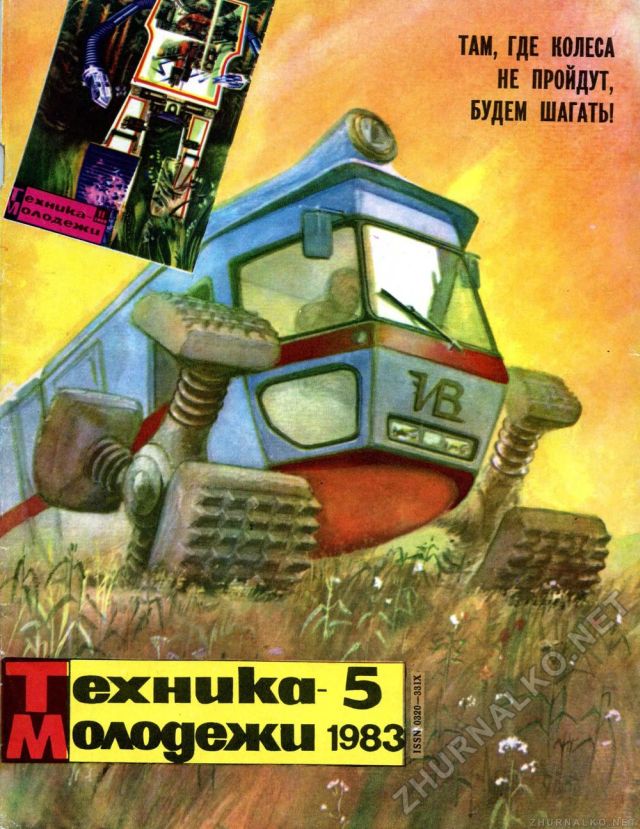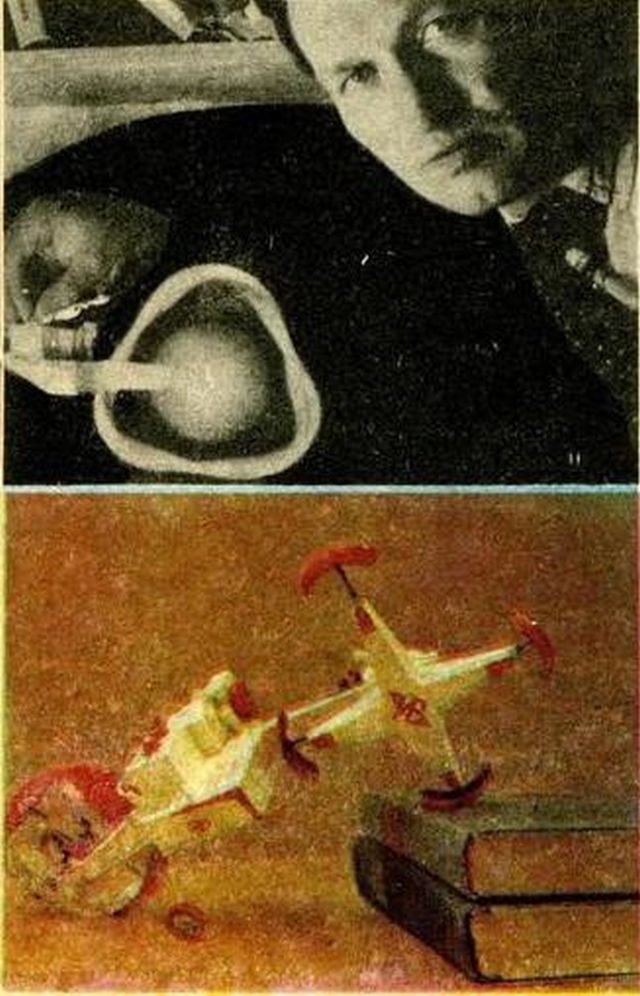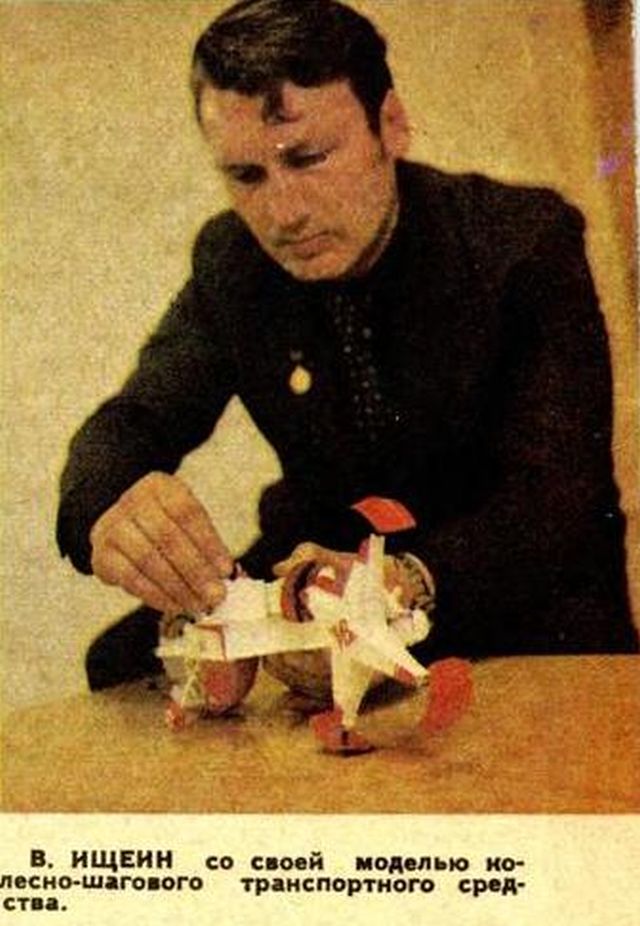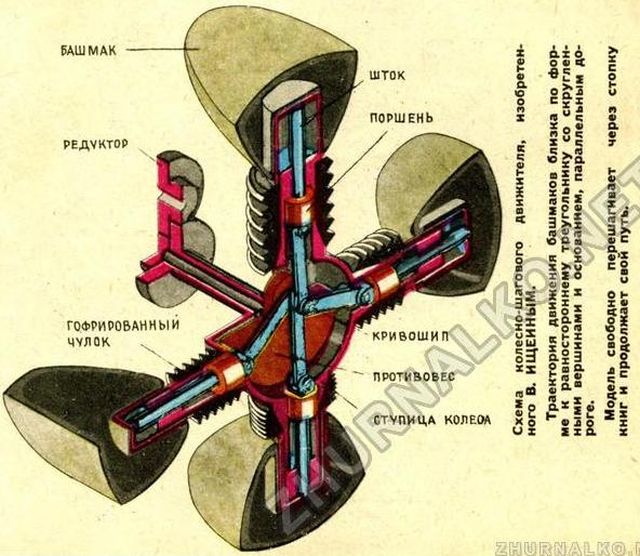1983 – Soviet Walking Wheel by Vladimir Ischein.
Google translation of original article here. I have not attempted to correct it.
During its 50-year history of our magazine § repeatedly told about the vehicles with conventional propulsion. In recent years, interest in beskolesiym machines has increased significantly. This is due primarily to the development of the Far North and the Far East, as well as other hard to reach areas where the transport problem is particularly acute. Prospectors, explorers, builders need high flotation technique: traditional, centuries wheel off-road becomes helpless. Which way to go!
To help designers came the young science of bionics, studying "patents" wildlife. Over millions of years of evolution, it has created a lot of perfect "mobile". According to its speed performance walking and running live "mechanisms" s almost inferior wheeled vehicles. A cross-country indicators they are much higher than that of the most advanced machines.
Using the findings of nature, the designers have created many different walking propulsion. Very original, for example, looked "pedicle device" (see .: «TM», â„– 11 in 1969). Tracking system, which is equipped with its design, as it connects the human leg with metal legs. Cost operator walked on the ground, and its mechanical twin hit the road at a rate far exceeding the speed of a pedestrian. Unfortunately, the practical application of the "pedicle device", however, as well as other non-standard design, and has not found.
Today, designers are trying to create a viable walking movers. And I must say, to
Biwa in this case some success. Edition presents to the readers and specialists develop engineer V. Ischeina who created the model of the vehicle with the original wheel-stepper-vym mover. Interested in the creative life of the young inventor.
As a student, Vladimir ische-in read an article by an engineer Kar-dashova "The new engine! Yes. Blades replace the pistons, "published in our magazine. He became interested in the construction of a new engine. Vladimir tried to eliminate its shortcomings. Came up with several options for connection blades, but they were already invented. It was certainly disappointing, but at the same time growing confidence: "I can and I am."
Lessons were not in vain. After that Vladimir realized how important to patent search, to be informed in the chosen field. His first certificate of authorship B. Ischein received for the development of the "hydraulic distributor." For this design Vladimir surprised himself was awarded the bronze medal of the USSR Exhibition of Economic Achievements.
Then he began to create walking and all sorts of other wheels. And in the end came up with a wheel diameter of variable for which to get exactly the copyright certificate, which is a sign of high quality invention.
Now V. Ischein continues to work to improve the wheels of various types. Draws up new applications.
As for the vehicle with the wheel-step mover, which has already been mentioned, it is in the summer of this year, will be on display in one of the exhibits of the USSR Exhibition of Economic Achievements. It is hoped that the construction of V. Ischeina attract the attention of specialists.
Roll or pitch?
(Or why not come up with the nature of the wheel)
VLADIMIR ISCHEIN engineer, Mr. M and N with a
One winter morning on the way to work I had to "boost" part of the way with a half-meter layer nametennogo night Buran snow. Carefully balancing on one leg, the other in the meantime I pulled out of a snowdrift, bore as far as possible, and carefully put the new location. Step, another step, another …
After a few minutes, considerably statute, out onto the sidewalk and cleared involuntarily thinking about energy process pacing. Immediately raised the question: why in the deep snow and swamp on the loose beach sand and dirt road we try to make the steps wider? Everyday experience tells me: so less tired. Indeed, the formation of deep track – a kind of technological
V. ISCHEIN with its model of co-FOREST-step vehicle.
process commensurate with the energy consumption by digging a small hole. And the less we "dig up holes" in the same section of the route, the less tire.
When walking on fragile soils almost all expended in moving the work expended in forming the next, and its magnitude is proportional to the volume of soil crushes. The length of the human small step and you have to make a lot of trails to go, let's say a snowy field.
We now consider the worst case, when the step length is reduced so that individual tracks merge into a continuous trail. At this mode, the power consumption increases by many times, and if a person get so move on virgin snow, it falls from exhaustion after a few hundred meters …
But it is precisely because their way wheel and caterpillar naisovremenneyshy ATVs! When you look at shrouded in a bluish exhaust conveyor, punching with the utmost stress two deep ruts in the mud, it seems as if someone mistook the purpose of this machine, turning it into a kind of time on a trencher. Volume crushes ground rolling several times more than during walking, and hence the whole chain of the greatest advantages of feet in front of the wheels. Here lies the first part of the answer to the question of the title: "In the context of cross-country nature of the energy
21
profitable to create in their wards imenro legs, not wheels. "
Unfortunately, the formation of wheel ruts not only have to spend a disproportionate amount of scarce fuel today, but also cause great harm to the nature.
An illustrative example – the Far North. Here in the tundra after each flight rover leaves a strip torn nezarastayuschie layer of moss, reindeer moss, which is the main food of deer and at the same time protects from destruction frozen ground. On the exposed areas as it melts, streams erode the track, forming a deep ditch, which last a long time, as if in silent reproach to remind us of the imperfection of the current movers.
Not cause as much damage to the national economy tractors and farm machinery, so that "proutyuzhivayut" soil, grain yields are often reduced by 36%, and in some cases, and all 50%.
Transition from rolling to the pacing at the same relative pressure on the ground several times reduce the area of ​​"traumatized" in the fields of soil, destroys moss, reindeer moss in the North, the broken ground on the roads.
Increased permeability during walking is primarily due to the ability to overcome larger obstacles, as well as a sharp decrease in the probability of slipping. All we have repeatedly witnessed the utter helplessness wheel when trying to get out of small holes led only to its deepening and subsequent "samozakapyvaniyu" to the very axis.
While released to the dirt wheel produces thrust by tangential forces of adhesion to the ground, the foot is pushed all the way by the forces at the base of the track. Moreover, if the wheel recess in the ground reduces his chances to get out, the deepening feet, on the contrary, this probability increases.
If the walking mechanism and slips, only slippery, but solid ground, where small depth formed track (clay, ice). But because of such conditions in nature are much less, then, of course, the use of a stepper mover leads to a reduction in fuel consumption and tire and allows more efficient use of traction qualities of the transport car.
In the exclusive terrain feet and is the second part of the
22
Council imposed on the title question: "… why nature has not come up with a wheel?" Indeed, because if she could create a beautiful and self-lubricating bearings with seals for them, could "invent" and muscular drive rotary motion. However, there is no beast, no insects with wheels scientists have found.
And for good reason. Too many defects in the "ideal" mover. Driving wheel of the car can not climb even a small step, if its height is more than one fifth of the diameter. A free man is crossing a vertical wall height equal to the length of the legs. On the "cross" is our four-legged friends – animals – needless to say.
Why, then, all our mobile machinery has not yet been "put on your feet?" Why wheel reigns supreme on the roads? First, of course, because of its simplicity and unpretentiousness, perfect balance and low cost. After the appearance of mechanical engines with rotary motion of the shaft wheel is the best solve the problem of transformation of the movement into a linear movement of the machine.
In only one pair of wheel friction bearing – axis, so its internal losses are minimal compared to any pacing mechanism. On paved roads, and even more so on the rails at the wheels are very small and the external cost associated with the deformation of the material of the road and the wheel in the area of ​​their contact. So in cities and on highways comfortable traditional propulsion hardly lose ground in the near future.
However, off-road wheels for ease of account for a very dearly. In many cases, it does not provide the required terrain. Caterpillar tracks more than passable, but it is much more difficult and unreliable, expensive and heavier.
It is not surprising, therefore, that first of all, a person tries to teach foot traffic is off-road machines. Imitating step in animals and humans were created "plantigrade" mechanisms with intricate movement articulated legs. As a rule, they differed very complex kinematics and imbalance, their design is full of rods, levers and hinges. Sustained return leg led to the inertial loads and sharply limited the speed.
The main way of technology aimed at steadily increasing speeds of machines and mechanisms, and this inevitably leads to a transition to the rotational movements wherever possible. And that began to emerge walking wheel which returns "exhaust" feet by rotating them around the axis. The simplest version of such an engine can be obtained by making a conventional wheel rim several deep cuts that provide a stepping motion mode. But because of the violent shaking and bumps encountered during PERMUT-pany, on this wheel does not go far. If the vertical oscillations of the axis is still possible to somehow
CORRUGATED STOCKING
CRANK HUB COUNTERWEIGHT KOJ1EOA
6ASHMAK
STEM
GEAR
PISTON
compensate specially constructed suspension, it strikes at the rigid structure of a walking wheel inevitable.
Hence, this requires dynamise wheel, that is to make it changing at transcend-nii. There have been attempts to implement it with the help of flexible elements, as was done, for example, Czech inventor Matskerle. Its design includes a number of flexible camera-feet fixed on the periphery of the wheel. Alternately supplying air to the chamber-shoes Matskerle achieved not only smoothness, but also made the wheel a whole new way to interact with the road for the first time the possibility of obtaining traction without applying torque to the hub. Upon pressurization chambers of the wheel is pushed from the ground in the same way as a skier running with sticks pushed snow. Senior rover "exercise bicycles" were manufactured, tested and delivered to the museum … Even small hole or mound proved insurmountable for him because of the small amount of deformation cameras.
However, this beautiful idea still continues to lure inventors, they are trying hard to eliminate the disadvantages of the "active" wheels. In Bauman Bauman attempted to set the camera on a radial stem extends, in Leningrad walked finally converted tractor "Belarus". He still had to keep the rotary drive wheels, combining it with the principle of "active" from the land of the repulsive gidrofitcirovannyh paws. Although the design looks cumbersome and slow-moving, it fulfills its mission – to develop more thrust.
Creating his own version of a walking wheel, I set the goal to get a universal mover, which could be successfully put on any ATV. Foreign design combined wheeled walking movers did not cause much excitement because of the complexity of the drive and violent shaking on the pacing mode (such as, for example, built in the United States, "Walking the devil" and "Paddy wagon", which are described in the book YS Ageykina "ATV wheel and dual propellers").
The main difficulty was to "force" the wheel axle to rotate without heave to find a simple and reliable device for a fairly large change in length of legs during walking. It appeared to be a normal crank mechanism housed inside the wheel hub. Its design is similar to the mechanism of star aircraft engine with a central crank. Only instead of the piston rods are connected with radially mounted rods, the ends of which are fixed elastic support shoes.
"Highlight" of the invention is that the crank shaft rotates faster than the hub, and as many times as the legs of the wheel. This condition is satisfied by a gearbox connecting coaxial shafts and crank hub. It was found that the optimal number of legs is four wheels, and the trajectory of the movement of their shoes at the same time close to an equilateral triangle with rounded tops and base parallel to the road. Wheel axle still has a small vertical oscillations of the motion, but with the help of selecting the parameters of the crank mechanism and the shape of the profile Clogs magnitude of these oscillations were able to "drive" in the range of 2-3% of the distance between the axle and the road.
By means of the crank shaft balances the wheel balance can be no worse than a conventional engine, which allows for "promotion" of up to several thousand revolutions per minute. While working on the wheel unwittingly got the idea that it is in itself is a kind of engine. It is only necessary to provide the piston rod, and the legs – cylinder and connect the latter through the valve with a pressure source located on the vehicle. Drive has been mo-torus-wheel can be air, steam, etc.. Etc.. Most promising hydraulic drive, successfully fought their way to the truck and agricultural machinery. This eliminates the need not only for hydraulic motors, but also gear. The resulting crank motor-you sokomomenten itself, plus the time of the crank shaft, before getting onto the hub, increasing four times the pressure reducer. In the case of a mechanical drive transmission machine is connected to the crank shaft and the gear again proves to be very useful because, in addition to its main function of the synchronization, it increases torque.
When the foot wheel is vertical, it creates thrust due to torque hub, but before the separation of the positions of the road leg is repelled from it mainly due to the extension rod – on the principle of "active" wheels. This should further increase the traction capabilities of machines with walking wheels.
Shoes are made in the form of air-filled rubber mounts with the protector on the outside and shaped, not prevent them from being out of the deep track. Since the area of ​​individual traces left by shoes is much smaller than the area of ​​the continuous track of the conventional tire, the stepping wheel should give large savings in the manufacture of a tire, as in the second operation. Tread tires round unproductive works: any portion thereof in contact with the road only a fraction of a second, and for nearly the whole turnover "idle." In walking the same wheel every shoe in contact with the road for a quarter of a turn, therefore, the efficiency of the tread above.
Attractive application of the wheels on the amphibious vehicle, where the machine feet thanks to the triangular his path properly will drive back the water and allow thus to abandon the special water propulsion. Would approach it and to wheelchairs to go as a flight of stairs and through the streets.
Currently, the Belorussian Polytechnic Institute are working to improve this design and create a prototype machine with walking wheels. Yet made a model. She playfully stomping on the floor and climbs steadily to a stack of books with a height of 20% greater than the height of the wheel axle. It seems just around the corner and a prototype machine.
23
See other early Walking Wheels and Walking Machines here.



